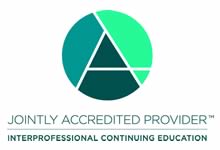
Original Launch Date: 1/31/2017
Expiration Date: 1/25/2023
ACCME PARS: 5800
This activity is intended for healthcare providers delivering care to women and their families.
After completing this activity, the participant should be better able to:
1. List key clinical considerations when assessing a patient with POP
2. Discuss the potential risks associated with synthetic mesh and grafts for the treatment of POP
Estimated time to complete activity: 0.25 hours
Postgraduate Institute for Medicine (PIM) requires faculty, planners, and others in control of educational content to disclose all their financial relationships with ineligible companies. All identified conflicts of interest (COI) are thoroughly vetted and mitigated according to PIM policy. PIM is committed to providing its learners with high quality accredited continuing education activities and related materials that promote improvements or quality in healthcare and not a specific proprietary business interest of an ineligible company.
The PIM planners and others have nothing to disclose. The OBG Project planners and others have nothing to disclose.
Faculty: Susan J. Gross, MD, receives consulting fees from Cradle Genomics.
Planners and Managers: PIM Planners have nothing to disclose
Participants must read the learning objectives and faculty disclosures and study the educational activity.
If you wish to receive acknowledgment for completing this activity, please complete the test and evaluation. Upon registering and successfully completing the test with a score of 100% and the activity evaluation, your certificate will be made available immediately.

In support of improving patient care, this activity has been planned and implemented by the Postgraduate Institute for Medicine and The ObG Project. Postgraduate Institute for Medicine is jointly accredited by the Accreditation Council for Continuing Medical Education (ACCME), the Accreditation Council for Pharmacy Education (ACPE), and the American Nurses Credentialing Center (ANCC), to provide continuing education for the healthcare team.
Postgraduate Institute for Medicine designates this enduring material for a maximum of 0.25 AMA PRA Category 1 Credit(s)™. Physicians should claim only the credit commensurate with the extent of their participation in the activity.
The maximum number of hours awarded for this Continuing Nursing Education activity is 0.2 contact hours.
Read Disclaimer & Fine PrintFDA (April 2019) ordered manufacturers of synthetic mesh for the treatment of Pelvic Organ Prolapse (POP) to discontinue sale and distribution in the US. ACOG responded with a Practice Advisory, which emphasizes that the FDA order applies only to mesh placed vaginally for POP and does not apply to (1) transvaginal mesh for SUI or (2) sacrocolpopexy (abdominal placement). POP is considered ‘benign’, but symptoms can seriously impact quality of life, affecting defecatory, voiding and sexual function.
Posterior Wall Prolapse
Anterior Wall Prolapse
It is imperative that local hospitals and health systems establish and strictly enforce robust processes to both/credential and audit surgeons with specific expertise, experience, training and skill to perform these procedures. AUGS has developed, and published credentialing guidelines for transvaginal mesh surgery for pelvic organ prolapse and sacrocolpopexy for the treatment of pelvic organ prolapse.
ACOG Practice Bulletin 214: Pelvic organ prolapse
AUGS: Update on FDA Announcement on Transvaginal Mesh for Prolapse
AUGS Position Statement on Restriction of Surgical Options for Pelvic Floor Disorders, March 26,2013
FIGO review of statements on use of synthetic mesh
Take a post-test and get CME credits
TAKE THE POST TESTAre you an
ObG Insider?
Get specially curated clinical summaries delivered to your inbox every week for free
Please log in to ObGFirst to access this page
OBG Project CME requires a modern web browser (Internet Explorer 10+, Mozilla Firefox, Apple Safari, Google Chrome, Microsoft Edge). Certain educational activities may require additional software to view multimedia, presentation, or printable versions of their content. These activities will be marked as such and will provide links to the required software. That software may be: Adobe Flash, Apple QuickTime, Adobe Acrobat, Microsoft PowerPoint, Windows Media Player, or Real Networks Real One Player.
This educational activity may contain discussion of published and/or investigational uses of agents that are not indicated by the FDA. The planners of this activity do not recommend the use of any agent outside of the labeled indications.
The opinions expressed in the educational activity are those of the faculty and do not necessarily represent the views of the planners. Please refer to the official prescribing information for each product for discussion of approved indications, contraindications, and warnings.
Participants have an implied responsibility to use the newly acquired information to enhance patient outcomes and their own professional development. The information
presented in this activity is not meant to serve as a guideline for patient management. Any procedures, medications, or other courses of diagnosis or treatment discussed or suggested in this activity should not be used by clinicians without evaluation of their patient’s conditions and possible contraindications and/or dangers in use, review of any applicable manufacturer’s product information, and comparison with recommendations of other authorities.
It appears you don't have enough CME Hours to take this Post-Test. Feel free to buy additional CME hours or upgrade your current CME subscription plan
You are now leaving the ObG website and on your way to PRIORITY at UCSF, an independent website. Therefore, we are not responsible for the content or availability of this site
